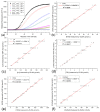Design and experimental approach to the construction of a human signal-molecule-profiling database
- PMID: 24351788
- PMCID: PMC3881147
- DOI: 10.3390/ijerph10126887
Design and experimental approach to the construction of a human signal-molecule-profiling database
Abstract
The human signal-molecule-profiling database (HSMPD) is designed as a prospective medical database for translational bioinformatics (TBI). To explore the feasibility of low-cost database construction, we studied the roadmap of HSMPD. A HSMPD-oriented tool, called "signal-molecule-profiling (SMP) chip" was developed for data acquisition, which can be employed in the routine blood tests in hospitals; the results will be stored in the HSMPD system automatically. HSMPD system can provide data services for the TBI community, which generates a stable income to support the data acquisition. The small-scale experimental test was performed in the hospital to verify SMP chips and the demo HSMPD software. One hundred and eighty nine complete SMP records were collected, and the demo HSMPD system was also evaluated in the survey study on patients and doctors. The function of SMP chip was verified, whereas the demo HSMPD software needed to be improved. The survey study showed that patients would only accept free tests of SMP chips when they originally needed blood examinations. The study indicated that the construction of HSMPD relies on the self-motivated cooperation of the TBI community and the traditional healthcare system. The proposed roadmap potentially provides an executable solution to build the HSMPD without high costs.
Figures







Similar articles
-
Concept and approach of human signal-molecular-profiling database: a pilot study on depression using Lab-on-chips.Annu Int Conf IEEE Eng Med Biol Soc. 2013;2013:4771-4. doi: 10.1109/EMBC.2013.6610614. Annu Int Conf IEEE Eng Med Biol Soc. 2013. PMID: 24110801
-
Common file formats.Curr Protoc Bioinformatics. 2007 Jan;Appendix 1:Appendix 1B. doi: 10.1002/0471250953.bia01bs16. Curr Protoc Bioinformatics. 2007. PMID: 18428774 Review.
-
Should software hold data hostage?Nat Biotechnol. 2004 Aug;22(8):1037-8. doi: 10.1038/nbt0804-1037. Nat Biotechnol. 2004. PMID: 15286656 No abstract available.
-
GeneKeyDB: a lightweight, gene-centric, relational database to support data mining environments.BMC Bioinformatics. 2005 Mar 24;6:72. doi: 10.1186/1471-2105-6-72. BMC Bioinformatics. 2005. PMID: 15790402 Free PMC article.
-
In-silico studies in Chinese herbal medicines' research: evaluation of in-silico methodologies and phytochemical data sources, and a review of research to date.J Ethnopharmacol. 2012 Apr 10;140(3):526-34. doi: 10.1016/j.jep.2012.01.041. Epub 2012 Feb 2. J Ethnopharmacol. 2012. PMID: 22326356 Free PMC article. Review.
Cited by
-
What You Need to Know Before Implementing a Clinical Research Data Warehouse: Comparative Review of Integrated Data Repositories in Health Care Institutions.JMIR Form Res. 2020 Aug 27;4(8):e17687. doi: 10.2196/17687. JMIR Form Res. 2020. PMID: 32852280 Free PMC article. Review.
References
-
- Sittig D.F., Wright A., Simonaitis L., Carpenter J.D., Allen G.O., Doebbeling B.N., Sirajuddin A.M., Ash J.S., Middleton B. The state of the art in clinical knowledge management: An inventory of tools and techniques. Int. J. Med. Inform. 2010;79:44–57. doi: 10.1016/j.ijmedinf.2009.09.003. - DOI - PMC - PubMed
-
- Biobank Norway. [(accessed on 20 September 2013)]. Available online: http://www.ntnu.edu/nb/web/biobanknorway.
-
- Cancer Registry of Norway. [(accessed on 20 September 2013)]. Available online: http://www.kreftregisteret.no/en/research/Janus-Serum-Bank/
Publication types
MeSH terms
Substances
LinkOut - more resources
Full Text Sources
Other Literature Sources

